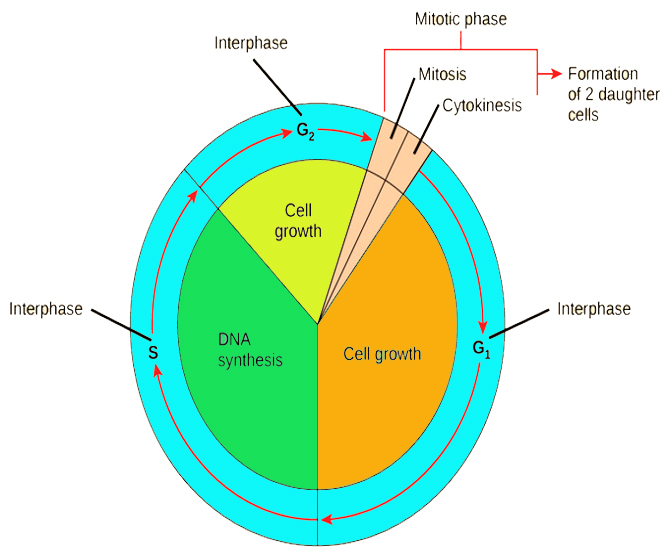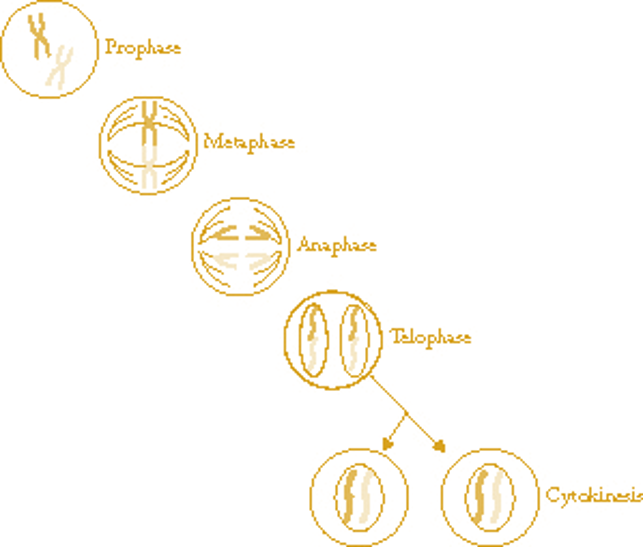- Every cell in our body produced by a pre-existing cell.
- process of cell formation from pre-existing cells is known as the cell cycle.
- Involves in many repetitions of cellular growth and reproduction, nuclear division.
- Almost all the living cells undergo a cell cycle (some exceptions like RBC).
- The cell cycle is separated into two phases:
- Interphase and mitosis
Different stages of the mitotic cycle and time duration:
| Part of cell cycle | Phase | Description of phase | Duration hr. (humans) |
| Interphase | G1 | Pre-DNA-synthesis | 12 |
| S | DNA-synthesis phase | 10 | |
| G2 | Post-DNA synthesis phase | 3 | |
| Mitosis | M | Mitotic phase | 1 |

Interphase:
- Interphase of a cell cycle includes three-phase:
- G1 phase, S phase, and G2 phase.
G1 phase
- After the completion of a cell cycle, the daughter cell begins the G1 phase of the new cell cycle.
- G1 is the resting phase.
- It is named as first gap phase.
- No DNA synthesis takes place during this stage.
- It involves the synthesis of RNA.
- During this phase, chromatin is fully extended.
- G1 involves transcription of rRNA, tRNA, and mRNA.
S phase (Synthesis phase)
- Replication of DNA starts.
- Synthesis of histone protein starts.
- S phase occupies 30-35% of the cell cycle.
G2 phase
- This a second gap or growth phase.
- During this phase, the synthesis of RNA and protein.
- Restores energy.
- It takes 10-25% time of the cell cycle.
Mitosis
- In Latin mito: threads.
- During the mitosis process, the nuclear material becomes visible and appears like threadlike chromosomes.
- Occurs in Somatic cells for the growth of cell number during embryogenesis and blastogenesis in plants, and animals.
M phase is split into the following steps:

Prophase (pro: before, phasis: appearance)
- The nuclear membrane starts disappearing.
- Formation of spindle fibers.
- Each chromosome of prophase is consisting of two coiled filaments.(Chromatids).
- The region where two chromatids joined is known as Centromere.
- Formation of sister chromatids.
- Cells become spheroid, more refractile, and viscous.
- During prophase, microscopic bodies are called Centrioles.
- Causes by an increase in cytosolic Ca2+
Prometaphase, Metaphase (Gr: meta: after, phasis: appearance)
- Breakdown of the nuclear envelope.
- Chromosome line up at the center of the cell.
- Spindle fiber interacts with chromosomes.
- When centrioles reach to poles of the cell, they’re surrounded by series of radiating microtubules recognized as Aster.
- The region where spindle fibers attached to the centromere acknowledged as kinetochore.
Anaphase (Gr: ana: up)
- Spindle filer pulls the chromosomes towards opposite poles.
- Splitting of the chromosomes into its sister chromatids (daughter chromosomes).
- Each daughter chromosomes having one kinetochore.
Telophase
- Chromosomes finally reach the opposite poles.
- Nuclear envelope reforms.
- The disappearance of spindle fibers.
Cytokinesis
- Process of the division of cytoplasm.
- Formation of two separate cells.
- Cytoplasm divides by a process recognized as Cleavage.
- puckering and furrowing of the plasma membrane is the first sign of cleavage in an animal cell.
- Cell pinch apart in animal cell and plant cell plate become the new cell wall
- In-plant cell cytokinesis occurs by other different processes due to a rigid wall.
- Cleavage doesn’t occur in plant cells.
- Formation of the Daughter cell.
- Daughter cells have a full set of chromosomes which is identical to the mother cell.
QUESTIONS:
- The number of centrosomes in animal cells?
- Purpose of mitosis?
- The process of nuclear division is known as?
Wow das is Good, awesome blog layout! How long have you been posting for? you make blogging look easy. The overall look of your site is super-wonderful, as well as the content unit!
Your site is awesome! I found it on Bing and couldn’t resist reading it. You have some good information here. Thanks for posting!